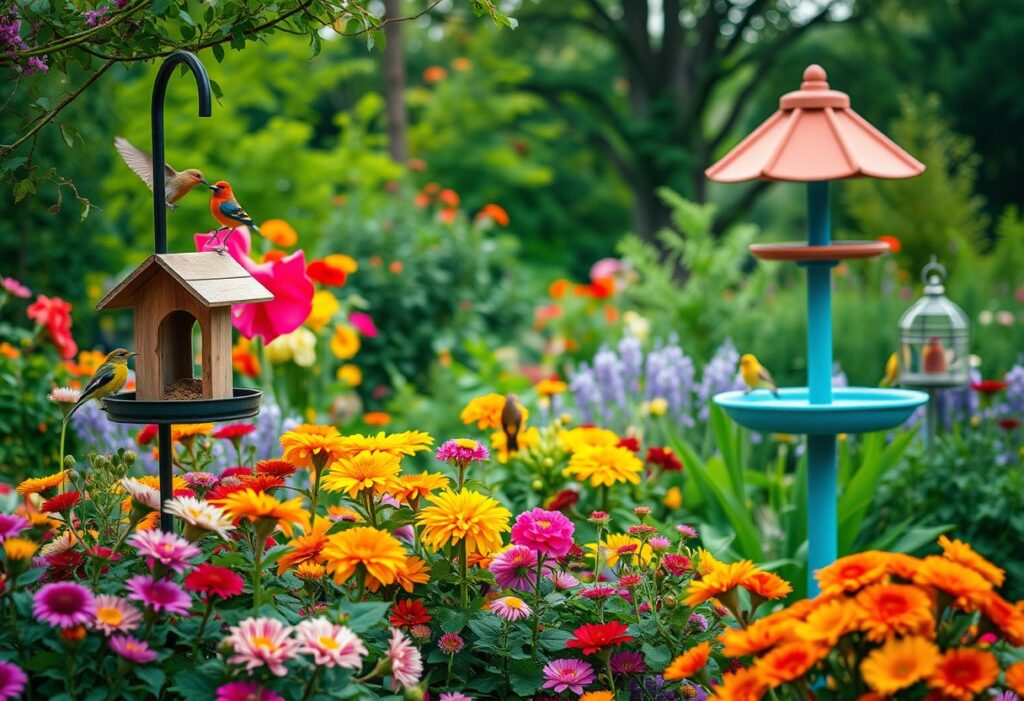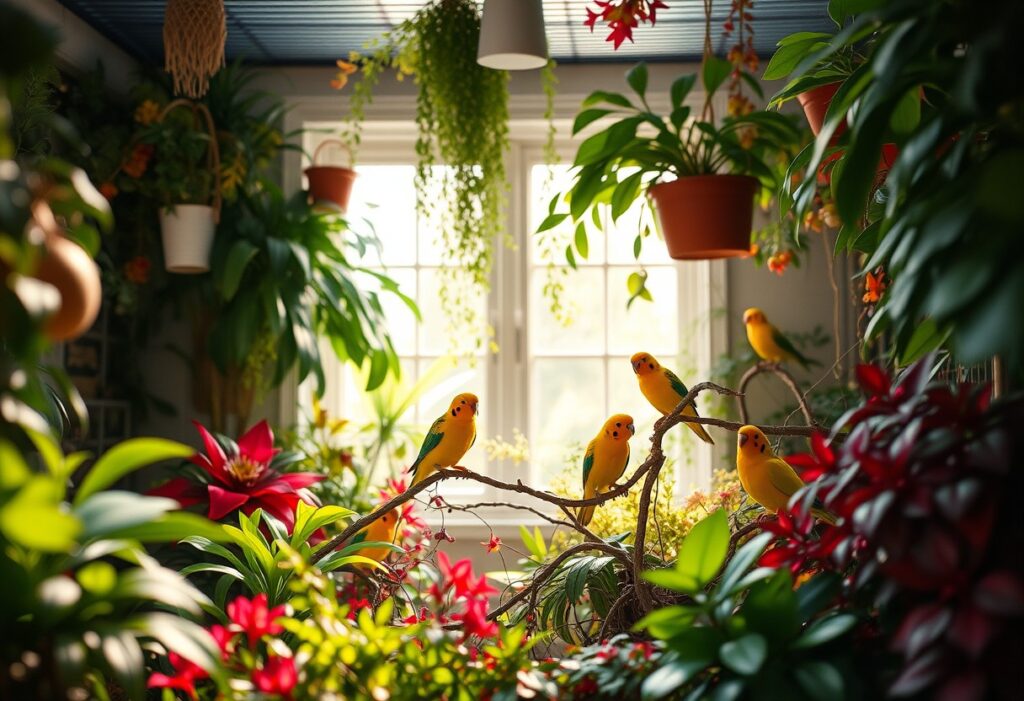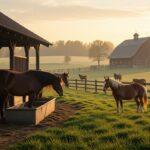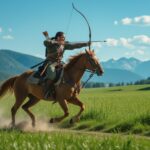There’s a wonderful sense of fulfillment when you cultivate a space that welcomes birds into your garden. By incorporating native plants, providing fresh water, and creating safe nesting areas, you can transform your outdoor space into a haven for both birds and yourself. This guide will walk you through important steps to attract and support local bird populations, ensuring your garden flourishes with the beauty and music of nature.
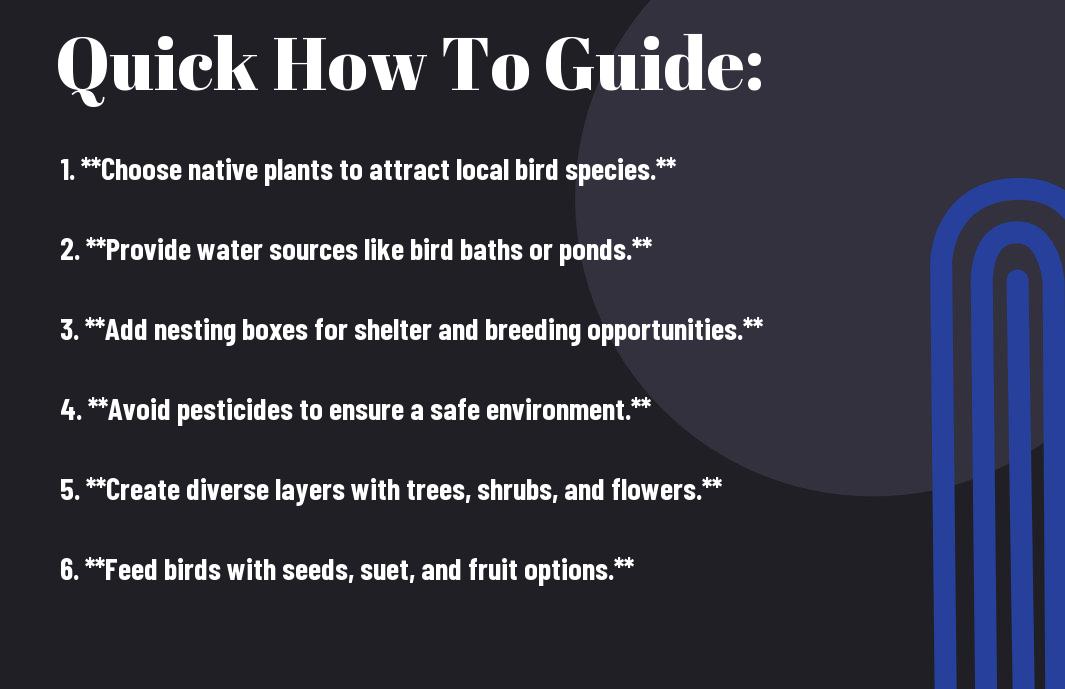

Understanding Bird Needs
To create a bird-friendly garden, it’s crucial to understand the specific needs of your feathered friends. Different species of birds have diverse requirements for food, water, and shelter, and addressing these needs will help ensure your garden becomes a safe haven for them. By catering to these crucial aspects, you can enhance not just the beauty of your garden but also its role as a supportive ecosystem for local wildlife.
Food Sources
One of the primary needs of birds is access to a reliable supply of food. Different bird species prefer different types of food, such as seeds, fruits, nectar, or insects. You can attract a wider variety of birds by incorporating a mix of feeding options in your garden. For instance, consider adding bird feeders filled with sunflower seeds for finches, and offer suet cakes for woodpeckers. Additionally, planting native flowers, shrubs, and trees can provide natural food sources such as berries and nectar.
Make sure to establish feeding stations that are properly placed. Avoid placing feeders too close to windows or high-traffic areas, as this can expose birds to predation and collisions. Keeping your feeders clean and filled regularly will also encourage birds to visit your garden throughout the year.
Water Requirements
Now that you have considered food sources, don’t forget the importance of water for birds. Access to clean water is crucial, especially during hot summer months or freezing winters when natural water sources may be scarce. Providing a birdbath is an excellent way to meet this critical need. Ensure it’s shallow enough for small birds to wade in safely, and consider adding some rocks to provide varying depths for different bird species.
A properly maintained birdbath can attract a wide range of birds and encourage them to visit your garden frequently. Change the water regularly to keep it fresh and avoid algae build-up. Additionally, in winter months, you might want to invest in a birdbath heater to prevent the water from freezing, ensuring your feathered visitors have access even when temperatures drop.
Shelter and Nesting Habitats
There’s another crucial aspect you need to consider: providing shelter and nesting habitats. Birds need safe spaces to rest, hide from predators, and raise their young. By incorporating dense shrubs, small trees, and native grasses into your garden design, you provide natural cover for them. Additionally, consider installing birdhouses that cater to various bird sizes and types, allowing them to find suitable nesting spots.
For instance, you might add birdhouses designed for bluebirds, wrens, or chickadees, each having their own specific requirements. The presence of native plants in your yard can also create a natural nesting environment, as they often offer the perfect materials for birds to construct their nests. Incorporating these elements into your garden underscores your commitment to fostering a safe and welcoming habitat for garden birds.
Designing a Bird-Friendly Garden
One of the most rewarding aspects of gardening is creating a space that supports local wildlife, particularly birds. This not only fosters biodiversity but also enriches your garden experience as you enjoy their vibrant colors, melodious songs, and natural behaviors. By carefully designing your garden with specific elements in mind, you can ensure that it becomes a sanctuary for feathered friends.
Choosing Native Plants
To attract the widest variety of birds to your garden, consider incorporating native plants. These plants are ideally suited to your local environment, providing vital food sources, shelter, and nesting materials for birds. Each region boasts its own selection of native flora that has evolved to coexist with local wildlife. Research which plants are natural to your area and focus on species that produce berries, seeds, or nectar, as these will provide lasting food for birds year-round.
In addition to being food sources, native plants create a more stable habitat that supports the entire ecosystem. They attract insects, which are crucial for young birds, and provide cover against predators. By cultivating a garden rich in native vegetation, you create a thriving environment that will entice a diverse array of bird species, from small songbirds to larger frugivores.
Creating Food Stations
On your journey to designing a bird-friendly garden, it’s vital to set up food stations. These can take the form of bird feeders stocked with seeds, suet, or nectar. Position these feeders in areas that are easily visible yet shielded from potential dangers, such as cats or strong winds. It’s important to keep these stations clean to prevent disease and ensure that food remains fresh.
Food stations don’t just attract birds; they can also invite a variety of other wildlife into your garden. However, remember that keeping your feeders stocked may require some effort, particularly during the harsh winter months or during migration seasons when birds rely heavily on supplemental feeding. By providing a reliable food source, you’ll encourage frequent visits from your feathered neighbors.
Incorporating Water Features
The importance of water features in a bird-friendly garden cannot be overstated. Birds need water not just for drinking, but also for bathing, which helps them maintain healthy feathers. Consider adding a birdbath or a small pond to your garden design. Ensure that the water is clean and refreshed regularly, as birds are more likely to visit a water source that is safe and inviting.
Garden water features can be as simple or elaborate as you desire. A shallow birdbath with rocks for perching or a small fountain can attract various bird species while adding beauty to your garden. By making sure it’s accessible and placed in an open area, you’ll draw more birds seeking both hydration and a place to groom themselves.

Tips for Maintenance and Care
All bird-friendly gardens require consistent maintenance and attention to detail to ensure that they remain welcoming spaces for various bird species. Regular monitoring of your garden not only helps in keeping it tidy but also allows you to cater to the birds’ needs effectively. Here are some useful tips to keep your garden thriving:
- Water sources should be kept clean and filled regularly.
- Remove any fallen fruits or seeds to prevent pest attraction.
- Monitor bird feeders and replenish them with fresh food frequently.
- Keep an eye out for invasive species that may threaten local flora.
- Be prepared to adapt your garden settings according to seasonal changes.
After incorporating these maintenance practices, you can enjoy a vibrant ecosystem flourishing with feathered friends.
Seasonal Considerations
For a truly bird-friendly garden, you need to consider the impact of seasons on both plants and bird activities. During the spring and summer months, birds are busily nesting and caring for their young. This means you may want to provide additional shelter, such as birdhouses or natural cover using dense shrubs, ensuring these areas remain undisturbed. You should also focus on adding a variety of native plants that provide seeds and pigments that attract insects, creating a natural food source for hatchlings.
As fall approaches, it’s wise to allow some natural leaf litter to accumulate, as this provides a foraging area for birds seeking insects and seeds. In winter, ensure that you have accessible food sources like suet or seed feeders, as many birds rely on supplemental feeding during colder months when natural food becomes scarce.
Pest Control and Safety
An important aspect of maintaining a bird-friendly garden involves managing pests and ensuring the safety of the birds that come to visit. You should avoid using harsh chemicals or synthetic pesticides, as they can be harmful to both birds and the environment. Instead, consider using natural pest control methods such as introducing beneficial insects like ladybugs or planting companion plants that repel harmful pests.
Additionally, you should regularly inspect your garden for any signs of disease or pests and take immediate action, if needed. Keeping your plants healthy not only benefits the birds but also enhances the overall beauty of your garden.
It is vital to educate yourself on which plants may attract unwanted pests and which beneficial species can coexist peacefully. Always opt for organic solutions when dealing with infestations, as they are safer for birds and other wildlife.
Pruning and Plant Care
Seasonal attention to pruning and plant care can significantly enhance the appeal of your garden. Refrain from heavy pruning during the nesting seasons, as this could disturb active nests. Instead, focus on light pruning after birds have completed their breeding cycles. This practice not only encourages healthy growth in your plants but also provides ample shelter for your feathered visitors.
Incorporating diverse plant heights and structures is imperative for creating a layered habitat that caters to various bird species. Regular care and attention to detail ensure that your plants thrive and attract different birds throughout the seasons.
Plant selection should be deliberate—opt for a mix of fruiting and flowering plants that offer food sources, as well as native varieties that need less maintenance, thus creating an inviting space for birds to thrive. With consistent attention, your garden can become a flourishing sanctuary for wildlife.
Summing up
Presently, creating a bird-friendly garden is a rewarding endeavor that not only enhances the beauty of your outdoor space but also supports local wildlife. By implementing a combination of native plants, water features, and safe nesting sites, you can attract a variety of bird species to your garden. Be sure to select plants that bloom at different times throughout the year to offer continuous food sources, and consider using bird feeders and baths to provide nourishment and hydration. Additionally, reducing pesticide use will create a healthier environment for birds and other beneficial insects.
Moreover, maintaining an awareness of your garden’s ecosystem is key to ensuring its sustainability. Regularly monitoring bird activity can help you understand their preferences, allowing you to adapt your landscaping techniques accordingly. In doing so, you will foster a harmonious relationship between your garden and the birds that inhabit it. Your commitment to creating a bird-friendly sanctuary not only benefits the avian community, but it also enriches your own experience in connecting with nature, offering a peaceful retreat right in your backyard.
FAQ: How to Create a Bird-Friendly Garden
Q: What are the necessary elements to include in a bird-friendly garden?
A: To create a bird-friendly garden, you should focus on incorporating native plants, providing water sources, and creating shelter. Native plants provide natural food sources through fruits, seeds, and nectar. Including a variety of plants that bloom at different times will attract a diverse range of bird species throughout the seasons. A birdbath or small pond can serve as a vital water source for drinking and bathing, while shrubs and trees offer safe spots for nesting and roosting. Additionally, avoiding pesticides will ensure a healthy environment for the birds and their food supply.
Q: How can I attract specific bird species to my garden?
A: To attract specific bird species, first, identify which birds are common in your area and their dietary preferences. Create a tailored environment by planting their favorite food sources. For example, hummingbirds are attracted to nectar-rich flowers like bee balm and salvia, while finches are drawn to sunflower seeds. Installing the right feeders stocked with birdseed, suet, or even fruit can also help draw in particular species. Moreover, include shelters that cater to their nesting habits, such as birdhouses designed for specific types of birds or dense shrubs for ground-nesting birds.
Q: What are the best practices for maintaining a bird-friendly garden?
A: Maintaining a bird-friendly garden involves several best practices. Regularly clean bird feeders and baths to prevent the spread of diseases among birds. Ensure that your plants are healthy by practicing organic gardening methods, such as companion planting and using natural pest control. Providing seasonal changes in bird-friendly features is also important; as seasons change, offer different food sources and cover for various bird species. Additionally, keeping an eye out for invasive plant species that could disrupt the local ecosystem and the birds you wish to attract is crucial. By fostering a safe and healthy environment, your garden can be a thriving haven for birds.
